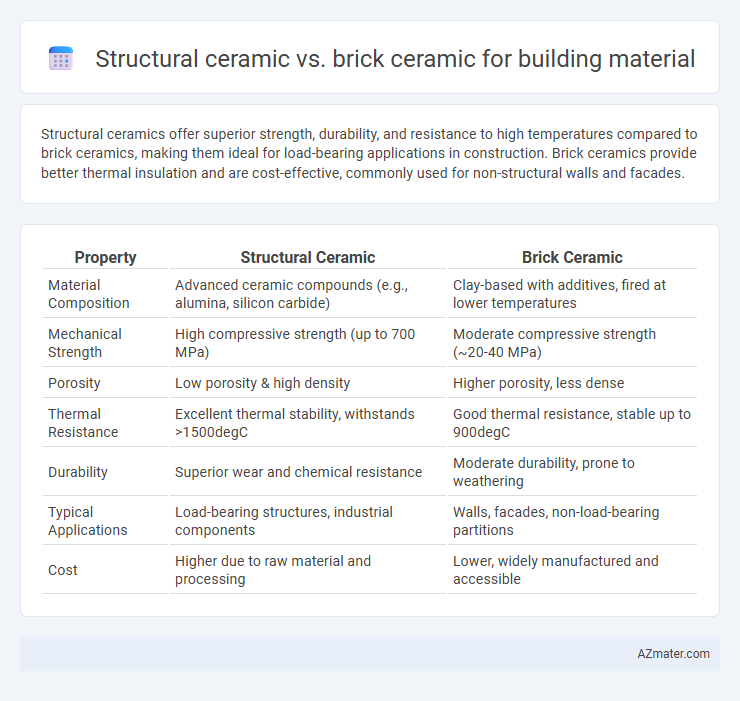Structural ceramics offer superior strength, durability, and resistance to high temperatures compared to brick ceramics, making them ideal for load-bearing applications in construction. Brick ceramics provide better thermal insulation and are cost-effective, commonly used for non-structural walls and facades.
Table of Comparison
| Property | Structural Ceramic | Brick Ceramic |
|---|---|---|
| Material Composition | Advanced ceramic compounds (e.g., alumina, silicon carbide) | Clay-based with additives, fired at lower temperatures |
| Mechanical Strength | High compressive strength (up to 700 MPa) | Moderate compressive strength (~20-40 MPa) |
| Porosity | Low porosity & high density | Higher porosity, less dense |
| Thermal Resistance | Excellent thermal stability, withstands >1500degC | Good thermal resistance, stable up to 900degC |
| Durability | Superior wear and chemical resistance | Moderate durability, prone to weathering |
| Typical Applications | Load-bearing structures, industrial components | Walls, facades, non-load-bearing partitions |
| Cost | Higher due to raw material and processing | Lower, widely manufactured and accessible |
Introduction to Structural Ceramic and Brick Ceramic
Structural ceramics, made from advanced materials like alumina and silicon carbide, offer high strength, wear resistance, and thermal stability ideal for load-bearing and high-temperature applications in construction. Brick ceramics, composed primarily of clay and shale, provide excellent insulating properties, durability, and moisture resistance, commonly used for walls and facades. Both materials serve critical roles in building, with structural ceramics excelling in mechanical performance and brick ceramics favored for traditional aesthetic and thermal insulation.
Composition and Manufacturing Differences
Structural ceramics are engineered using high-purity alumina, silicon carbide, or zirconia, providing enhanced mechanical strength and thermal resistance, while brick ceramics primarily consist of clay mixed with sand and other natural materials. The manufacturing process of structural ceramics involves precise powder processing, high-temperature sintering, and sometimes hot pressing to achieve dense, defect-free components, whereas brick ceramics are formed by molding clay mixtures followed by kiln firing at lower temperatures. These compositional and manufacturing distinctions result in structural ceramics exhibiting superior durability, hardness, and performance in demanding construction applications compared to traditional brick ceramics.
Strength and Durability Comparison
Structural ceramics exhibit superior strength and durability compared to brick ceramics, making them ideal for load-bearing applications in construction. The high compressive strength of structural ceramics, often exceeding 200 MPa, ensures enhanced resistance to mechanical stress and environmental wear. In contrast, brick ceramics generally have lower compressive strength, around 20-40 MPa, which limits their use to non-structural or decorative purposes where durability requirements are less demanding.
Thermal Insulation Properties
Structural ceramics offer superior thermal insulation properties compared to brick ceramics due to their lower thermal conductivity and higher resistance to heat flow. Brick ceramics, while providing moderate insulation, tend to have higher porosity and thermal mass, which can result in greater heat retention and slower dissipation. Selecting structural ceramics enhances energy efficiency in buildings by minimizing heat transfer and maintaining stable indoor temperatures.
Moisture and Weather Resistance
Structural ceramic exhibits superior moisture and weather resistance compared to brick ceramic, making it ideal for harsh environmental conditions. Its low porosity and dense microstructure prevent water absorption, reducing the risk of frost damage and efflorescence. In contrast, brick ceramic tends to have higher permeability, which can lead to increased moisture retention and subsequent deterioration under prolonged exposure to weather elements.
Load-Bearing Capabilities
Structural ceramics exhibit superior load-bearing capabilities compared to brick ceramics due to their higher compressive strength and enhanced fracture resistance, making them ideal for critical structural elements. Brick ceramics typically have lower density and porosity, which reduces their ability to withstand heavy loads but provides better thermal insulation properties. Engineers prioritize structural ceramics in high-stress applications like columns and beams, while brick ceramics are often used for non-load-bearing walls and facade treatments.
Sustainability and Environmental Impact
Structural ceramics offer superior durability and thermal insulation compared to brick ceramics, reducing the need for frequent repairs and lowering energy consumption in buildings. Brick ceramics typically involve higher embodied energy due to firing processes and often generate more waste during manufacturing. Choosing structural ceramics enhances sustainability by minimizing carbon footprint and promoting resource efficiency in construction.
Cost and Economic Considerations
Structural ceramic offers higher strength and durability compared to brick ceramic, often resulting in lower long-term maintenance costs despite a higher initial price. Brick ceramic is generally more affordable upfront and widely available, making it a cost-effective choice for budget-conscious construction. Economic considerations favor brick ceramics for residential projects with tight budgets, while structural ceramics suit commercial and industrial buildings requiring enhanced performance and longevity.
Applications in Modern Construction
Structural ceramics offer superior mechanical strength, thermal resistance, and durability, making them ideal for load-bearing components and high-temperature environments in modern construction. Brick ceramics excel in insulation, aesthetic appeal, and cost-effectiveness, commonly used for exterior walls, facades, and partition walls. Both materials contribute to energy efficiency and structural integrity, with structural ceramics favored for advanced infrastructural demands and brick ceramics prevalent in residential and commercial building envelopes.
Choosing the Right Ceramic Material for Your Project
Structural ceramics offer superior strength, durability, and resistance to high temperatures and chemical corrosion, making them ideal for load-bearing and industrial applications. Brick ceramics excel in thermal insulation, cost-effectiveness, and ease of installation, suited for residential and non-structural projects. Selecting the right ceramic depends on project requirements, including mechanical performance, environmental exposure, and budget constraints.

Infographic: Structural ceramic vs Brick ceramic for Building material
 azmater.com
azmater.com